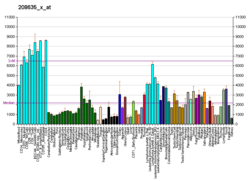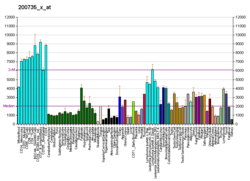NACA (gene)
Nascent-polypeptide-associated complex alpha polypeptide, also known as NACA, is a protein which in humans is encoded by the NACA gene.[5][6][7]
Function
NACA prevents short recently synthesized (i.e., nascent) ribosome-associated polypeptides from inappropriate interactions with cytosolic proteins. NACA binds nascent-polypeptide domains emerging from ribosomes unless it contains a signal peptide which is fully exposed. Depletion of NACA from ribosomes carrying nascent polypeptides allows the signal recognition particle (SRP) to crosslink to polypeptides regardless of whether or not they contain signal peptides or not. In the absence of NACA, proteins lacking signal peptides can be mis-translocated into the endoplasmic reticulum.[6][8]
The NACA protein is expressed in bone during development and acts as a transcriptional coactivator in conjunction with acidic activators.[7]
Interactions
NACA has been shown to interact with BTF3, FADD,[9] C-jun,[10] and 3 members of taxilin family.[11]
References
- 1 2 3 GRCh38: Ensembl release 89: ENSG00000196531 - Ensembl, May 2017
- 1 2 3 GRCm38: Ensembl release 89: ENSMUSG00000061315 - Ensembl, May 2017
- ↑ "Human PubMed Reference:".
- ↑ "Mouse PubMed Reference:".
- ↑ "Entrez Gene: NACA nascent-polypeptide-associated complex alpha polypeptide".
- 1 2 Wiedmann B, Sakai H, Davis TA, Wiedmann M (August 1994). "A protein complex required for signal-sequence-specific sorting and translocation". Nature. 370 (6489): 434–40. doi:10.1038/370434a0. PMID 8047162.
- 1 2 Yotov WV, St-Arnaud R (February 1996). "Mapping of the human gene for the alpha-NAC/1.9.2 (NACA/1.9.2) transcriptional coactivator to Chromosome 12q23-24.1". Mamm. Genome. 7 (2): 163–4. doi:10.1007/BF03035343. PMID 8835540. Archived from the original on 2000-09-16.
- ↑ Rospert S, Dubaquié Y, Gautschi M (October 2002). "Nascent-polypeptide-associated complex". Cell. Mol. Life Sci. 59 (10): 1632–9. doi:10.1007/PL00012490. PMID 12475173.
- ↑ Stilo R, Liguoro D, di Jeso B, Leonardi A, Vito P (April 2003). "The alpha-chain of the nascent polypeptide-associated complex binds to and regulates FADD function". Biochem. Biophys. Res. Commun. 303 (4): 1034–41. doi:10.1016/S0006-291X(03)00487-X. PMID 12684039.
- ↑ Moreau A, Yotov WV, Glorieux FH, St-Arnaud R (March 1998). "Bone-specific expression of the alpha chain of the nascent polypeptide-associated complex, a coactivator potentiating c-Jun-mediated transcription". Mol. Cell. Biol. 18 (3): 1312–21. PMC 108844. PMID 9488446.
- ↑ Yoshida K, Nogami S, Satoh S, Tanaka-Nakadate S, Hiraishi H, Terano A, Shirataki H (May 2005). "Interaction of the taxilin family with the nascent polypeptide-associated complex that is involved in the transcriptional and translational processes". Genes Cells. 10 (5): 465–76. doi:10.1111/j.1365-2443.2005.00848.x. PMID 15836775.
Further reading
- Wiedmann B, Sakai H, Davis TA, Wiedmann M (1994). "A protein complex required for signal-sequence-specific sorting and translocation". Nature. 370 (6489): 434–40. doi:10.1038/370434a0. PMID 8047162.
- Maruyama K, Sugano S (1994). "Oligo-capping: a simple method to replace the cap structure of eukaryotic mRNAs with oligoribonucleotides". Gene. 138 (1–2): 171–4. doi:10.1016/0378-1119(94)90802-8. PMID 8125298.
- Yotov WV, St-Arnaud R (1996). "Mapping of the human gene for the alpha-NAC/1.9.2 (NACA/1.9.2) transcriptional coactivator to Chromosome 12q23-24.1". Mamm. Genome. 7 (2): 163–4. doi:10.1007/BF03035343. PMID 8835540.
- Suzuki Y, Yoshitomo-Nakagawa K, Maruyama K, et al. (1997). "Construction and characterization of a full length-enriched and a 5'-end-enriched cDNA library". Gene. 200 (1–2): 149–56. doi:10.1016/S0378-1119(97)00411-3. PMID 9373149.
- Yotov WV, Moreau A, St-Arnaud R (1998). "The alpha chain of the nascent polypeptide-associated complex functions as a transcriptional coactivator". Mol. Cell. Biol. 18 (3): 1303–11. PMC 108843. PMID 9488445.
- Moreau A, Yotov WV, Glorieux FH, St-Arnaud R (1998). "Bone-specific expression of the alpha chain of the nascent polypeptide-associated complex, a coactivator potentiating c-Jun-mediated transcription". Mol. Cell. Biol. 18 (3): 1312–21. PMC 108844. PMID 9488446.
- Munz B, Wiedmann M, Lochmüller H, Werner S (1999). "Cloning of novel injury-regulated genes. Implications for an important role of the muscle-specific protein skNAC in muscle repair". J. Biol. Chem. 274 (19): 13305–10. doi:10.1074/jbc.274.19.13305. PMID 10224091.
- Beatrix B, Sakai H, Wiedmann M (2001). "The alpha and beta subunit of the nascent polypeptide-associated complex have distinct functions". J. Biol. Chem. 275 (48): 37838–45. doi:10.1074/jbc.M006368200. PMID 10982809.
- Zhang QH, Ye M, Wu XY, et al. (2001). "Cloning and functional analysis of cDNAs with open reading frames for 300 previously undefined genes expressed in CD34+ hematopoietic stem/progenitor cells". Genome Res. 10 (10): 1546–60. doi:10.1101/gr.140200. PMC 310934. PMID 11042152.
- Sims RJ, Weihe EK, Zhu L, et al. (2002). "m-Bop, a repressor protein essential for cardiogenesis, interacts with skNAC, a heart- and muscle-specific transcription factor". J. Biol. Chem. 277 (29): 26524–9. doi:10.1074/jbc.M204121200. PMID 12011100.
- Kim SH, Shim KS, Lubec G (2002). "Human brain nascent polypeptide-associated complex alpha subunit is decreased in patients with Alzheimer' s disease and Down syndrome". J. Investig. Med. 50 (4): 293–301. doi:10.2310/6650.2002.33287. PMID 12109594.
- Behrends U, Jandl T, Golbeck A, et al. (2002). "Novel products of the HUD, HUC, NNP-1 and alpha-internexin genes identified by autologous antibody screening of a pediatric neuroblastoma library". Int. J. Cancer. 100 (6): 669–77. doi:10.1002/ijc.10550. PMID 12209604.
- Mossabeb R, Seiberler S, Mittermann I, et al. (2002). "Characterization of a novel isoform of alpha-nascent polypeptide-associated complex as IgE-defined autoantigen". J. Invest. Dermatol. 119 (4): 820–9. doi:10.1046/j.1523-1747.2002.00518.x. PMID 12406326.
- Strausberg RL, Feingold EA, Grouse LH, et al. (2003). "Generation and initial analysis of more than 15,000 full-length human and mouse cDNA sequences". Proc. Natl. Acad. Sci. U.S.A. 99 (26): 16899–903. doi:10.1073/pnas.242603899. PMC 139241. PMID 12477932.
- Stilo R, Liguoro D, di Jeso B, et al. (2003). "The alpha-chain of the nascent polypeptide-associated complex binds to and regulates FADD function". Biochem. Biophys. Res. Commun. 303 (4): 1034–41. doi:10.1016/S0006-291X(03)00487-X. PMID 12684039.
- Papachristou DJ, Batistatou A, Sykiotis GP, et al. (2003). "Activation of the JNK-AP-1 signal transduction pathway is associated with pathogenesis and progression of human osteosarcomas". Bone. 32 (4): 364–71. doi:10.1016/S8756-3282(03)00026-7. PMID 12689679.
- Hämmerle K, Shayan P, Niemeyer CM, Flotho C (2003). "Expression analysis of alpha-NAC and ANX2 in juvenile myelomonocytic leukemia using SMART polymerase chain reaction and "virtual Northern" hybridization". Cancer Genet. Cytogenet. 142 (2): 149–52. doi:10.1016/S0165-4608(02)00841-5. PMID 12699894.
- Ota T, Suzuki Y, Nishikawa T, et al. (2004). "Complete sequencing and characterization of 21,243 full-length human cDNAs". Nat. Genet. 36 (1): 40–5. doi:10.1038/ng1285. PMID 14702039.
- Al-Shanti N, Steward CG, Garland RJ, Rowbottom AW (2004). "Investigation of alpha nascent polypeptide-associated complex functions in a human CD8(+) T cell ex vivo expansion model using antisense oligonucleotides". Immunology. 112 (3): 397–403. doi:10.1111/j.1365-2567.2004.01893.x. PMC 1782496. PMID 15196207.
- Ballif BA, Villén J, Beausoleil SA, et al. (2005). "Phosphoproteomic analysis of the developing mouse brain". Mol. Cell. Proteomics. 3 (11): 1093–101. doi:10.1074/mcp.M400085-MCP200. PMID 15345747.






